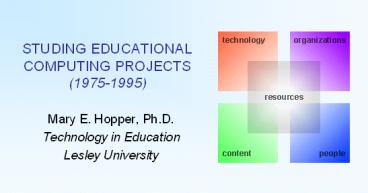STUDING EDUCATIONAL COMPUTING PROJECTS 19751995 - PowerPoint PPT Presentation
1 / 19
Title:
STUDING EDUCATIONAL COMPUTING PROJECTS 19751995
Description:
Danny Dunn and the Homework Machine Kids try to teach a computer to ... Participants: Gregory Jackson, Naomi Schmidt, Janet Daly, Anne Lavin, Larry Bucciarelli ... – PowerPoint PPT presentation
Number of Views:99
Avg rating:3.0/5.0
Title: STUDING EDUCATIONAL COMPUTING PROJECTS 19751995
1
STUDING EDUCATIONAL COMPUTING PROJECTS(1975-1995
)
- Mary E. Hopper, Ph.D.
- Technology in Education
- Lesley University
2
Context, Personal Background
- Danny Dunn and the Homework Machine
Kids try to teach a computer to do their homework
(BUT find process requires more work learning
) Exemplifies my view of Education ??
Computing - Honeywell TSS System in High School 1976-1980
- Paper Tape, Teletype, Phone Hook-up for
Interactive Networked System of 11 High Schools,
Assignments from BASIC to debugging PLATO
StarTrek program. Collection1 Box
3
Official Project Description in Paper
- Long-term project evolved from a qualitative
research study in the early 1990s to point of
transition where it is today. - Goal remains the sameImprove the viability of
educational computing projects by identifying
effective and sustainable strategies. - Historically, this is a relatively common goal.
(Taylor, 1980 McClintock, 1986 OTA, 1988).
4
Further Background
- Ph.D. Program at Purdue University, Indiana
- Illinois is next door to U. of Illinois
geographically. - Started inheriting more original documentation
and lore from Bitzers PLATO system from my
program faculty. - Doctoral Advisor, Robert Lawler, worked on Logo
and had extensive resources he caught on I
collected. - He pitched into waste baskets, I retrieved and
saved. - Also many other projects in U.S. mid-west like
MECC. Collection5 Boxes
5
Unofficial Motivation for First Study
- Time to choose subject for dissertation
- I said, why not study the projects I have
already started collecting some material about? - He said, No, document what you learned on the
project you have been working on and then go to
document successful projects at MIT Brown.
6
Purdue University, Freshman Engineering
Educational Research and Information Systems,
Founded Directed by Bill LeBold, IEEE
Fellow(Mentor with Tri-appointment in 3 Schools,
EE/Psy./Ed.)
- ESCAPE Engineering Specific Career-exploration
and Problem-solving Environment - NSF Funded, 5000 screens info. system.
- Ported HyperCard? HyperNews/Suns, 1989-90
7
Official Motivation for First Study
- By 1990 it was clear to both of us that
educational computing projects would soon be
using that very quickly emerging distributed
computing paradigm. - Experience on a project in a distributed
computing environment in 1989-1990 led to my
strong belief that new projects would encounter
problems that were a function of distributed
computing that would threaten their success.
8
Samples of Tomorrow from Yesterday
- Decided to explore how problems of previous
educational computing initiatives became
intertwined with new problems that were a
function of distributed computing (Hopper, 1993).
- Studied experimental educational projects using
distributed computing environments that dated
back to the 1970s and could be analyzed with
hindsight by their participants by 1990s.
9
Methods of Formal Study in Paper
- Initial study took place between 1990-1993.
- In-depth interviews extensive documentation.
- (Essentially qualitative/ethnographic
approach.) - Historical case studies that captured
participant's recollections, insights and hind
sights about the development of the educational
projects in the earliest distributed computing
environments.
10
Pursued Multiple Perspectives
- Academic Computing System Officials/Developers
- Educational Software Project Directors
- Educational Software Project Mangers
- Educational Software Project Developers
- Students/Users
11
Brown University Institute for Research and
Information Scholarship (IRIS)
- Context32 (Intermedia ? StorySpace ? WWW)
- Participants Paul Kahn, Nicole Yankelovich,
George Landow (Later contact with vanDam/Nelson) - Emphatic about key of systems design for ed.
apps, no line between user and designer ? strong
usability. - AUX 1.1, Project being ended as I arrived in
1993. - Landows grad student porting files to
StorySpace.
12
Massachusetts Institute of Technology Athena and
Academic Computing Aero/Astro Engineering
- Athena Project, Created X-Windows Kerberos
- Funding of Ed. Projects Let 1000 Flowers Bloom
- TODOR (Athena, BLOX) / Mechanics 2.01 (cT)
- Participants Gregory Jackson, Naomi Schmidt,
Janet Daly, Anne Lavin, Larry Bucciarelli
13
Massachusetts Institute of Technology Center for
Educational Computing Initiatives Civil
Engineering Department
- AthenaMuse, Multimedia Extensions to X-Windows,
not propagated by X Consortium as was planned,
included advanced multimedia authoring system.
Interestingly, CERN was partner in 1980s, humm - Physical Geology Tutor (Athena, AthenaMuse)
- Participants Steve Lerman, Ben Davis, Evelyn
Schlusselberg, Pat Kinnicutt
14
Technology Critical in Data Collection Analysis
15
Resulted in Model Based on Analysis of
Relationships
16
Incredibly Brief Results
- Projects were characterized by simultaneous
attention to a consistent set of key factors
across educational, technical organizational
contexts. - Organizational issues more critical than
expected! - Continuous change and expansion of underlying
system caused the need for change to survive. - End of delivery or modification caused projects
to very quickly fall from unused to unusable.
17
Results (Continued)
- To insure that the projects in distributed
computing environments were used, updated and
expanded, authors needed to find ways to
continually acquire critical resource. - Major factor in success was degree to which
projects directors found ways to address new
technical challenges within constraints of
traditional academic organizational structures.
18
Discussion
- This study produced valuable advice about how to
implement educational projects in distributed
computing environments. - Not surprisingly, advice was also applicable to
educational computing projects that began to
exploit the World Wide Web as it emerged. - Much more detail in paper and even more online!
- Collection50 Boxes
19
Further Information
- Mary Hopper, Ph.D., Professor, Lesley U.,
2003-Now - Web http//www.theworld.com/mehopper
- Email mhopper_at_mail.lesley.edu































